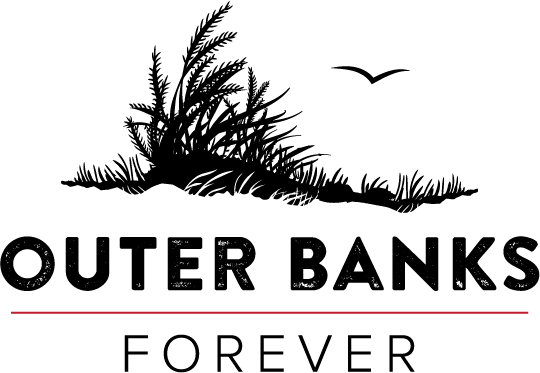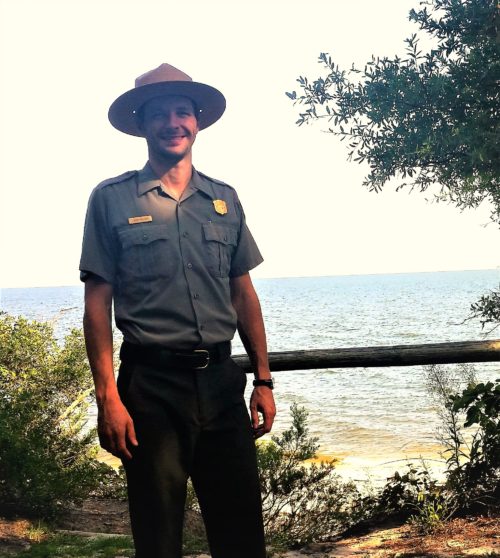Hometown: Starks, Maine
Education: Unity College, majoring in Parks, Recreation, and Ecotourism
Where you’ll find him: Lead Park Ranger, Fort Raleigh National Historic Site
What do you do as Lead Park Ranger at Fort Raleigh?
My job is basically to oversee the visitor center and the day to day operations of the park. I also do programs with the public right now, so my position is a mix between being on the front lines and leading longer-term planning projects.
When did you know that you wanted to be a park ranger?
I’ve known since I was 5 or 6, whatever age I started thinking about what I wanted to be when I grew up. As soon as I knew what a career was, I wanted to be a park ranger. When I was traveling with my family growing up, we would visit national parks. I saw these rangers as sort of the “outdoor cop” and that was cool when I was little. The only thing that’s changed is that I when I grew up, I wanted to do more with education and not law enforcement.
What other parks have you worked in?
I’ve been all over – Acadia National Park in Maine, Wind Cave National Park in South Dakota, Carlsbad Caverns National Park in New Mexico, Crater Lake National Park in Oregon, Zion National Park in Utah, the Manhattan Project National Historic in Los Alamos, New Mexico, and now I’m here at Fort Raleigh National Historic Site.
What brought you to the Outer Banks?
It was an opportunity to take the next step in my career, but there’s a lot more to it than that – a change in scenery was appealing. I’d been in the southwest for a long time and part of what I love about this job is the ability to move with it. You go and experience totally different places. You can live in the mountains, you can live in the desert, and now I have the opportunity to live on the seashore. That change in environment is partly nomadic spirit. That’s me. I came from Carlsbad Caverns most recently, and I knew I wanted something different. This park met the criteria of being extremely different from southern New Mexico and the stories at Fort Raleigh are unique. I also love just to explore a new environment. I’m unfamiliar with the beach so now I get to experience the beach. I guess I have to shift from having caving as my hobby to some sort of water sport!
What is your favorite thing about being a park ranger?
There are a few things: First is getting opportunities to meet and interact with people from all over the world. The second is being able to share a place with them that they are unfamiliar with – whether that be a historic story or a physical environment. I guess I’m more used to the physical environment given the parks I’ve worked in previously. For example taking someone on a crawling tour of a cave, that’s an experience they don’t have in their normal, everyday life. Being able to provide that for them is really what makes the job worthwhile.
I also enjoy the learning aspect of my job. Coming here to Fort Raleigh people expected that I knew the Lost Colony story, but I actually only knew a little about it. The way I see it is, my job is to learn and communicate. It doesn’t matter what the information that’s being communicated is, whether it be the history of the Lost Colony or explaining cave formation, it’s the ability to take information, find the meanings of it, understand the idea behind it and convey it in a concise, easy to understand way so visitors can connect to it.
What is your favorite education program at Fort Raleigh?
The Freedmen’s Colony – It’s something people often are not expecting when they arrive here. If they’ve heard anything about Fort Raleigh, they’ve heard about the English exploration and the Lost Colony story. They’ll be surprised when they learn that this site has more stories than that. It can be pretty impactful when you really get into the heart of what was happening during the Freedmen’s Colony time and the effect that it had on people’s lives. I’ve seen a lot of visitors get very engaged with and sometimes emotional about the Freedmen’s Colony story and the idea of starting from zero during that time. I think that’s a powerful story to be able to share.
What is your favorite memory of your time here so far?
I really like walking the Thomas Hariot Trail. It’s a tiny little trail, you could walk it in 10 minutes, but if you take more time it’s such a cool little trail. I find the beach out there very relaxing. One day I was roving in the park and I walked the trail and met 2 guys who were sitting on the wooden jetties going out in the water, their feet in the sand. I stopped to say ‘Hi’ and asked them how their visit was going. One of them said “Oh, it’s going great! I’m more relaxed now than I have been in 5 years.” He gave me a specific time frame, so obviously he was thinking back to a time something had happened in his life and the fact that Fort Raleigh National Historic Site, this little park on the end of Roanoke Island, was giving him this experience away from that. That’s what he’s going to remember – just being able to finally be relaxed after several years. I think that’s a power our national parks have.

